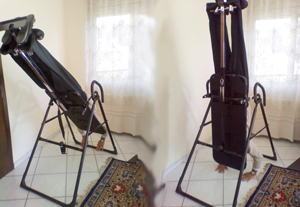
Inversion Tables and Low Back Pain
Of the many questions the chiropractors at Schonhard Chiropractic are asked almost daily, one of the most frequent ones is, "Are inversion tables good for your spine/lower back pain/sciatica/mid-back pain/neck pain/headaches?" For most people, the simple answer is yes, but there are some risks associated with inversion tables.
The concept of hanging upside down and taking pressure off of the spine makes sense to the chiropractors at Schonhard Chiropractic. The majority of conditions the chiropractors treat in their office involve osteoarthritis, degenerative disc disease, and degenerative joint disease. All of these conditions are accounted for by the compressive forces of gravity over many years, which break down the spine and its associated structures.
As chiropractors, the concept of decompressing the spine with the use of an inversion table is a solid notion, but only reaps lasting benefits when used regularly. Using the inversion table in a crisis situation would not be advisable unless your condition has been evaluated by a chiropractor or other medical professional because of the potential risk factors involved. It may not be a good idea to use an inversion table if you have a history of any of the following conditions:
- Vertigo
- Glaucoma, detached retina, chronic sinusitis
- Hypertension, high blood pressure, anticoagulant medication
- Dizziness, lightheadedness, tingling or seizure
- Recent surgery, obesity, pregnancy
- Hernia, gallbladder condition, acid reflux, kidney disease
- Fractures, foot pathology, scoliosis, osteoporosis
- Stroke, severe headache, TIA, intracranial bleed, history of brain trauma
Inversion tables may benefit many, but as seen above there are potential risks. Before starting the use of inversion therapy you should contact a licensed professional (chiropractor, P.T., D.O., M.D.) and make sure the benefits will outweigh all risks. Call the Husband & Wife Chiropractic Team at Schonhard Chiropractic today!
